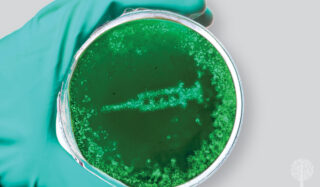Mushrooms can be grown using various methods, but no matter the process, there has to be a starting material. The starting material consists of mycelium of a pure culture in a test tube, on an agar plate, or macerated in a syringe. But that pure culture itself has to come from somewhere. A pure culture of a mushroom fungus can be derived from a mushroom’s tissue culture or by propagating spores collected from a mushroom. A growing number of vendors offer spores of many mushroom-forming species in syringes, on spore prints, or in vials.
Preloaded Spore Syringes
Preloaded spore syringes are probably the most convenient way to inoculate a substrate with minimal equipment. One installs the needle on the syringe body (if it is not pre-installed) and injects the contents (using some semblance of sterile technique) into a bag or jar containing sterile grain, straw, sawdust, wood chips, or other media. Pretty straightforward.
Syringes provide an easy method of performing the multi-spore technique of generating mushroom-producing dikaryons. Not all species (e.g., Agaricus bisporus, the commercial button mushroom) require the formation of a dikaryon to be able to produce mushrooms, but others do. To generate random dikaryons, many spores are grown near each other, resulting in fusions between hyphae from spores having compatible mating types. When injecting directly into a fruiting substrate, expect genetic diversity in the resulting fruit bodies because mycelia of many different genetic combinations will colonise the substrate.

Isolating Dikaryons
A way of directly isolating dikaryons is by spreading spores from a syringe onto an agar surface and collecting hyphae from regions where primordia form. Primordia can take up to a month or more to appear. Primordia are tiny bundles of hyphae formed by successful matings that show up as dot-like structures on the mycelial surface. Primordia can later develop into mushrooms.
Isolation of colonies derived from single spores is readily accomplished by applying a small amount of spore solution from a syringe onto an agar surface and diluting it with additional sterile water. The concentration of spores in a syringe can vary widely, so some experimentation is required to get the dilution just right so that individual colonies can be picked off the agar surface before fusing with a neighbor.
More Than Spores
So, besides spores, what exactly do you get with a spore syringe? The spores are most often suspended in sterile distilled water, providing a nutrient-free environment that, although well-hydrated, is not conducive to germination. Spores of many fungi will germinate on plain water agar, but germination requires active cellular respiration and, therefore, oxygen. Spores on an agar surface have access to adequate oxygen, but spores surrounded by high-purity water in a syringe do not, so they tend to remain dormant. Dormancy is well maintained under typical refrigeration at around 4°C. Spores can remain viable in a syringe for 18 months or more if cold.
A bit of surfactant (detergent) added to a spore solution will help prevent spores from sticking and clumping together, and you may find some vendors using it. This is only advantageous in the case above, where single spore isolates are desired. Should anything else be added to the spore solution to preserve the spores or kickstart germination? Probably not. The point is to keep them dormant. They don’t need a built-in energy source since that will be provided once released into a nutrient-rich environment.